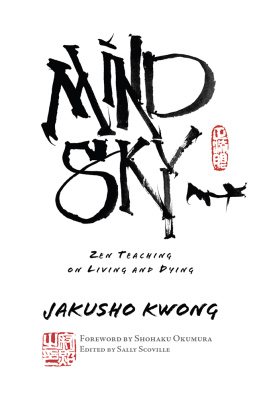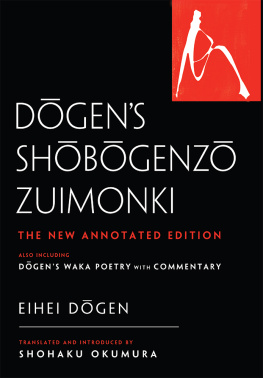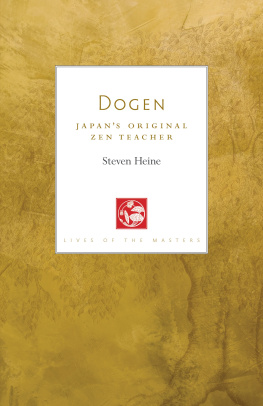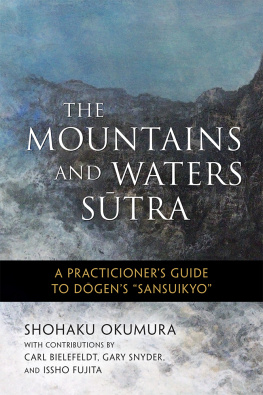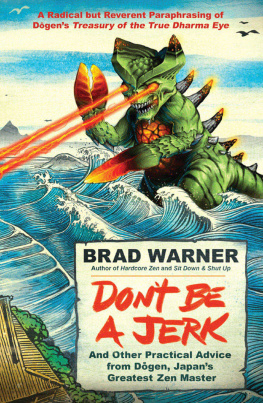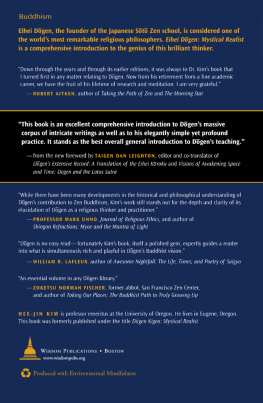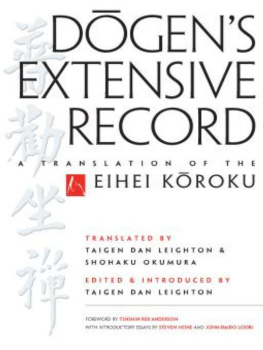Dōgen - Eihei Koroku I-V
Here you can read online Dōgen - Eihei Koroku I-V full text of the book (entire story) in english for free. Download pdf and epub, get meaning, cover and reviews about this ebook. year: 2013, genre: Religion. Description of the work, (preface) as well as reviews are available. Best literature library LitArk.com created for fans of good reading and offers a wide selection of genres:
Romance novel
Science fiction
Adventure
Detective
Science
History
Home and family
Prose
Art
Politics
Computer
Non-fiction
Religion
Business
Children
Humor
Choose a favorite category and find really read worthwhile books. Enjoy immersion in the world of imagination, feel the emotions of the characters or learn something new for yourself, make an fascinating discovery.

- Book:Eihei Koroku I-V
- Author:
- Genre:
- Year:2013
- Rating:3 / 5
- Favourites:Add to favourites
- Your mark:
- 60
- 1
- 2
- 3
- 4
- 5
Eihei Koroku I-V: summary, description and annotation
We offer to read an annotation, description, summary or preface (depends on what the author of the book "Eihei Koroku I-V" wrote himself). If you haven't found the necessary information about the book — write in the comments, we will try to find it.
Dōgen: author's other books
Who wrote Eihei Koroku I-V? Find out the surname, the name of the author of the book and a list of all author's works by series.
Eihei Koroku I-V — read online for free the complete book (whole text) full work
Below is the text of the book, divided by pages. System saving the place of the last page read, allows you to conveniently read the book "Eihei Koroku I-V" online for free, without having to search again every time where you left off. Put a bookmark, and you can go to the page where you finished reading at any time.
Font size:
Interval:
Bookmark:
Translated by Thomas Cleary
Introduction
Eihei Koroku is a record of speeches and poetry of the eminent Buddhist Master Dogen (1200-1253), who is celebrated as one of the founders of Zen in Japan.
Like the historical Buddha, Dogen was originally groomed for secular government, but abandoned that life to seek spiritual enlightenment.
Dogen left worldly life on the eve of his debut at court. He was barely in his teens at the time, but he had already been reading Buddhist literature on the side for several years. Sheltered and tutored by older relatives in Buddhist orders, he was eventually ordained as a monk in the influential Tendai sect, which had been established in Japan for four centuries.
Tendai Buddhism in Japan was divided into exoteric and esoteric branches, and Dogen is said to have studied both. His writings and speeches often reflect the central texts of exoteric Tendai, especially the Lotus Sutra and the Stopping and Seeing meditation manuals of the Chinese founder of the school. Distinct traces of the esoteric teachings, based on the premise of buddhahood in this very body, with extensive use of structured mental exercises, formulaic recitation, and symbolic art and ritual, can also be seen in Dogens work.
After reading the entire Buddhist canon twice over and learning the principles and practices of exoteric and esoteric Tendai Buddhism, Dogen took to the study of Zen Buddhism in a form newly introduced to Japan, a combination of Tendai and recently imported Chinese Chan Buddhism.
After some years of Zen study in Japan, Dogen traveled to China with his teacher to study Chan as it was then practiced there in its land of origin. Dogen called on a number of teachers in China, and ultimately elected to practice under the tutelage of the teacher he refers to his talks as Tendo, after the name of the mountain where he was teaching at the time. It is to this teacher that Dogen attributes the guidance crucial to his own awakening.
At that time Chan Buddhism was over six hundred years old in China, and had accumulated a large body of teaching lore. Dogen was the first pilgrim to bring the classic koan collection The Blue Cliff Record back to Japan, and he often cites and comments on stories from this book in his own writings and speeches. Dogen also quotes from other prominent collections of koans, or official decisions, precedents from the ancient masters, which would later be expanded into major casebooks by Cao-Dong masters on the model of The Blue Cliff Record.
Dogens original Zen teacher in Japan followed the so-called Oryu or Yellow Dragon sect of the Rinzai school of Zen. Of some two dozen lines of Rinzai Zen introduced into medieval Japan from China, this was the only one that followed the Yellow Dragon way, and Dogen was the last master. His own sayings include extensive citations from the original Chinese master for whom the school is named, illuminating Dogens consciousness of this heritage and its characteristic approach to Chan Buddhist practice.
One of the distinguishing characteristics of Yellow Dragon Chan may be seen in a famous story about how the original Chinese master used a teaching device that he had constructed himself. According to Zen Lessons, he used three passwords in private teachingHow is my hand like a Buddhas hand? How is my foot like a donkeys foot? Everyone comes from somewhere; what are your circumstances of birth? Not many people could penetrate them; and even when someone did try to respond, the master would just close his eyes and sit still without any sign of approval or disapproval. A Taoist recluse asked the master about this; he replied, One who has passed the barrier goes on freely; one who asks the gatekeeper whether or not it is alright has not yet gone through the pass.
Dogens main Chinese Chan teacher, the one he cites as Tendo, lived from 1163 to 1228 and was a master of the Cao-Dong school of Chan, called Soto Zen in Japan. Dogen also draws on the work of an earlier master of this school, the distinguished Hongzhi (1091-1153; Wanshi in Japanese), including citations of Wanshis own speeches as well as his comments on ancient cases.
In addition to a wide range of Chan Buddhist lore, Dogen also employs stories, sayings, and symbols from scriptures, treatises, and other canonical sources. A clue to the purpose of this richness of texture in this work may be gleaned from the Lotus Sutra, which was the central scriptural basis of the Tendai school into which Dogen and all the other early Japanese Zen masters were initiated, and which Dogen cites most frequently in his own writings. The Lotus Sutra was an important source for Chan Buddhist teachings in China for centuries before Zen was established in Japan, including the prototype of the Five Ranks device of the Cao-Dong school of Chan. The Five Ranks system was studied intensively in Japanese Soto Zen, and used as a classification scheme for koans.
Dogens work rehearses the perennial issue of progress, which is central to the Lotus Sutra. In his Secret Shobogenzo, Dogen writes, If you dont really know the task of progress of Buddhas, you will stagnate and not pass through the progress of Buddhas. If you do not pass through, there is no transcending the realm of demons.. What this means is suppose you reach Buddhahood: Buddhahood is when it is realized by the Buddha awaited yesterday that the Buddha of today is already there. To go on informing the Buddha that todays Buddha has never been only today is called the task of progress of Buddhas.
Stressing the need to go beyond nirvana, in Shobogenzo Dogen also writes, There is ceasing the traces of enlightenment, which causes one to forever leave the traces of the enlightenment that is cessation. The warnings in the Lotus Sutra about the dire consequences of rejecting the teachings beyond nirvana dramatize degenerative results of the stagnation of which Dogen warns. The expansive array of Dogens speeches and writings, like the classics and scriptures he cites, is designed to provide for an antidote to stagnation and degeneration, setting up developmental contemplative exercises known as the network of locations, the interchange of principal and associates, and traveling from Buddha-land to Buddha-land.
In his written works Dogen gave out a variety of instructions for meditation to realize the essential mental freedom underlying this advanced development. A technique represented as the secret of Soto Zen obtained from oral tradition was also introduced into Rinzai Zen teaching by the eighteenth century master Hakuin, who attributed an early mental and physical breakdown to overexertion with koans.
According to Hakuins recital, on asking for instruction Dogen was told by his Chinese teacher Tendo, This Chan sect of ours has traditionally been based on not leaving the meditation hall, and actually practiced by just sitting. Now it often happens in various places that even if they only sit for long periods without lying down they dont meet enlightened teachers and dont learn the right way to enter concentration. Therefore its not different from the sitting meditation of deviant pathshow could they ever succeed in entering the great concentration of the Buddhas?
When Dogen then asked for instruction in the right way to enter concentration, Tendo told him to place his mind in his left palm when he sat in meditation. Dogen went and did this.
One day Dogen came to Tendo and told him that he had followed instructions to put his mind in his left palm, but now his hands had disappeared, and so he had nowhere to place his mind.
Now Tendo told him to put his mind in his whole body: You must make your mind fill your whole body; dont leave a single space empty in your three hundred and sixty joints and eighty-four thousand pores.
Font size:
Interval:
Bookmark:
Similar books «Eihei Koroku I-V»
Look at similar books to Eihei Koroku I-V. We have selected literature similar in name and meaning in the hope of providing readers with more options to find new, interesting, not yet read works.
Discussion, reviews of the book Eihei Koroku I-V and just readers' own opinions. Leave your comments, write what you think about the work, its meaning or the main characters. Specify what exactly you liked and what you didn't like, and why you think so.


